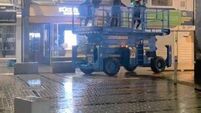Cork manslaughter trial: Jury warned of ‘major’ miscarriage of justice

Adrian Henry, of Seminary Road, Blackpool, Cork, is on trial for the manslaughter of James Duncan at Patrick Street in Cork on September 12, 2019. He denies the charge. Picture: Cork Courts Limited
THE prosecution in a manslaughter trial allege that a man was injured when assaulted at a soup kitchen on the street in Cork city, as a result of which he was “a dead man walking”.
However, the defence claim that looking at the evidence in this way could result in “a major miscarriage of justice”.
Adrian Henry of Seminary Road, Blackpool, Cork, is charged with the manslaughter of James Duncan, aged 40, at Patrick Street in Cork on September 12, 2019.
He denies the charge and is on trial at Cork Circuit Criminal Court before Judge Helen Boyle and a jury of eight men and four women. The late Mr Duncan was from Dunmore Gardens, Knocknaheeny, in Cork.
Lawyers for both sides addressed the jury at the close of the evidence in the case.
Prosecution senior counsel Ray Boland said the Mr Henry assaulted the deceased.
“The assault was sudden, violent, and dangerous. Sudden — there was precious little preamble and it happened very quickly. Violent — a witness said she saw he was pushed forcefully to the ground and dragged on the road in the face of oncoming traffic and dropped. Being dragged into traffic was the dangerous aspect.
“[Witness] Aoife O’Connor said he dropped him forcefully on the ground; that he had dragged him by the hood out into traffic and drops him. It is a matter of common sense that he would fall on his head.
“You heard from [pathologist] Dr Ong that unfortunately Mr Duncan, as well as looking vulnerable, that inside his head he was particularly vulnerable to this injury of subdural haematoma. You could say Mr Henry is unfortunate because of Mr Duncan’s vulnerability, but Mr Duncan is more unfortunate. As a result of the assault he died. This injury which killed him was as a result of the assault.
“Once the subdural haematoma started, he was a dead man walking. He was walking and he was talking… It did not happen instantly like having your head chopped off. It happened insidiously — it was a gradual and rapid deterioration. You can track that from the evidence.
“In most manslaughter cases you don’t hear the voice of the deceased. Extraordinarily, in this case you do. You have the recording of his conversation with the emergency service.
“Yes, there are witnesses who say he [the deceased] was intoxicated. In my observation of CCTV he was moving slowly and carefully but he was not falling over. In the 999 call, that is not someone out of their minds on drink, not someone who is stocious.
“My view is that he suffered this subdural haematoma in the course of the assault.”
Defence senior counsel Tom Creed said the deceased had“almost time-bomb vulnerabilities”. He reminded the jury of the “extraordinary situation that someone without a mark on him” died as a result of whatever happened to him.
“The prosecution, in the guise of inference, is asking you to speculate. They are asking you to infer or speculate that he banged his head in the first incident. I am not saying to you he did not bang his head. Dr Ong said the subdural haematoma would require his head to strike something. It would be disingenuous to say he did not hit his head. But I say the prosecution did not prove a particular head strike. He may have struck it twice. But it would be speculation to say he struck his head the first time [when pushed to the ground] rather than the second time [when he slid down the side of a parked car] or both...
“If two versions are reasonably open to you on the evidence then you must adopt the version most favourable to the accused.
“If you follow what the prosecution says to you, we could be looking at a major miscarriage of justice. If the subdural haematoma was caused by the second fall, not the first, then it is not caused by any action on the part of Mr Henry,” Mr Creed said.
Judge Helen Boyle will address the jury on Monday on the legal issues that they must bring to bear in their deliberations.










 App?
App?





